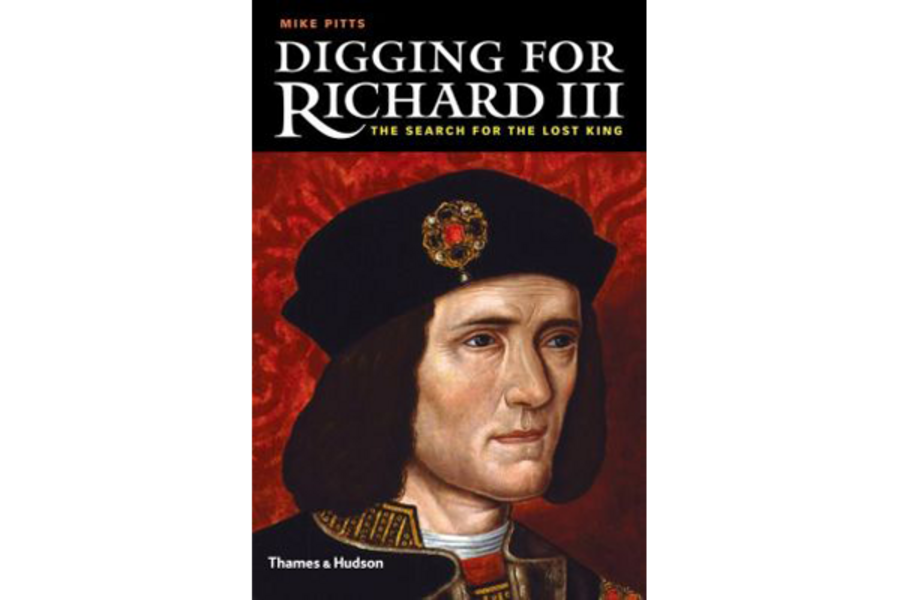'Digging for Richard III' is an engaging account of the sleuthing, research, and public fascination behind a very unusual excavation
Loading...
The 2012 excavation that discovered the remains of King Richard III in a Leicester parking lot was strange from the start. The entire project stemmed from a psychic premonition about a buried skeleton worthy of Indiana Jones. Once underway, archaeologists proceeded to dig amidst camera crews, tourists, and amateur history buffs dressed as medieval knights. And on the first day of excavation researchers chanced upon the very discovery they least expected: the battle-scarred bones of slain 15th-century monarch Richard III, the last English king to die in battle.
The odd mix of science and sensationalism that surrounded the dig offers an interesting showcase of modern archaeological methods and popular mania for the tangible traces of history. Mike Pitts’ Digging for Richard III: The Search for the Lost King is a brief and engaging account of the scientific sleuthing, historical research, and public fascination that drove this unusual excavation.
Contemporary chronicles record that Richard was killed at the Battle of Bosworth in 1485. The site of battle lies just outside the modern city of Leicester, where King Richards Road, Tudor Grocers, and Bosworth Street are just a few of the still-visible reminders of medieval history. After Richard was slain, Henry VII tossed his naked body over the back of a horse and rode into Leicester to display the corpse.
What happened next is less clear. One tradition held that his body was thrown into the River Soar; other sources indicated that he was buried at the nearby church of the Greyfriars. Whatever the fate of his remains, nearly everyone assumed they were lost or buried at an unknowable spot now covered by modern buildings.
The story took a mystical twist when a screenwriter named Philippa Langley got interested in the location of Richard’s remains. Langley was writing a screenplay about Richard III, and during a visit to Leicester she followed the directions of a local history society to a parking lot where some records suggested the king was buried. As she was walking around the area in 2004, she felt a sudden premonition when she reached a particular spot. She was convinced that she was standing over Richard’s grave.
Many other people needed to be convinced before excavation could begin. Chief among them was Richard Buckley, an archaeologist affiliated with the University of Leicester. Like most professional archaeologists, Buckley was more interested in using excavations to reconstruct social history than embarking on a treasure hunt for the bones of a famous historical figure. But Buckley wanted to learn about life at the medieval friary that once stood at the site where Langley had her intuition, so he agreed to help her. He figured the odds of finding the monarch’s remains were infinitesimal.
With support from the University of Leicester and a Richard III society whose members call themselves the Fellowship of the White Boar, excavation of the parking lot finally began in 2012. Both Shakespeare and medieval chroniclers present Richard as a monstrous villain, his physical deformity an emblem of his vicious character. Langley hoped that skeletal evidence could show the claims of deformity were simply slanders invented by later writers.
On the first day of excavation at the parking lot, an archaeologist spotted what appeared to be a human bone mixed in with the dirt. TV crews and journalists were already following the story, but the researchers kept the find a secret until they knew more. The bone was part of a fairly complete skeleton, indicating a formal burial, and it was located at the medieval level. Langley was certain they had found the lost king, but the archaeologists remained skeptical.
Suggestive evidence continued to accumulate. The skeleton showed signs of violent death in battle, appeared to belong to a young male, and had a severely curved spine, which could explain the deformity noted in historical sources. After several months of expert analysis and extensive testing that compared DNA from the skeleton to the genomes of Richard’s living descendants, researchers from the University of Leicester publicly confirmed that they had discovered the remains of Richard III.
Pitts’ story begins with medieval history and ends with genetic testing and a global media circus. It’s a fascinating and improbable tale, and a recurring theme is just how easily things might have been otherwise. Langley could have rejected her hunch, or Buckley might have dismissed her eccentric enthusiasm. Builders in later centuries might have destroyed the grave, and archaeologists almost missed the skeleton entirely while excavating. Its discovery was a surreal collision of the majestic and the mundane: a famous English monarch buried beneath a grimy urban parking lot.
Forensic analysis revealed that Richard died after receiving a devastating blow to the back of his skull. A second major head wound showed evidence of a blade penetrating 10.5 cm into his brain, and a third wound in the buttocks was probably inflicted after he died. His death, it seems, was as brutal and bloody as his life.








